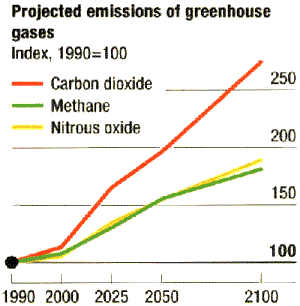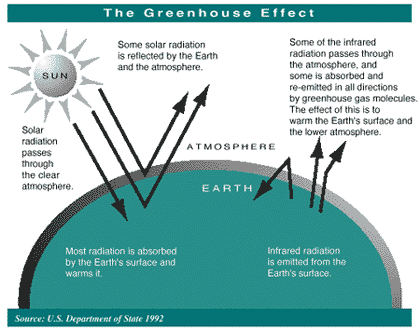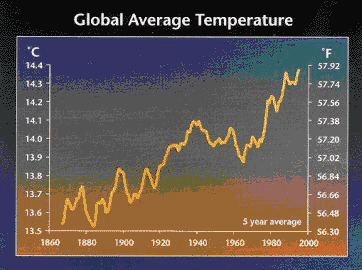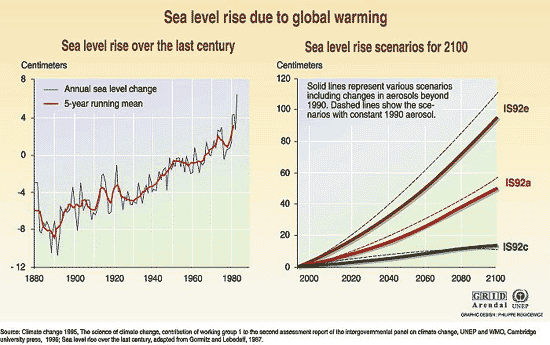Kyoto Protocol
Global warming is a topic that has leaped into world-wide public consciousness with a vengeance in the last few decades. Famine and disease are on the rise; oceans are warming up; and glaciers have been shrinking for more than 100 years, seriously affecting a number of social factors, not the least of which is drinking and irrigation water.
 The Kyoto Protocol amends The United Nations Framework Convention on Climate Change (UNFCCC) document to a stronger-worded international treaty with countries signing on the dotted line. The amendment requires each country to legally ratify its intention to reduce six toxic greenhouse-gas emissions and taking a stand against further damage to the environment. The six include carbon dioxide, hydrofluorocarbons (HFCs), methane, nitrous oxide, perfluorochemicals (PFCs), and sulfur hexafluoride.
One hundred forty-one countries have ratified the treaty as of June 2005; notable exceptions include the United States and Australia. Among the reasons given for not signing the agreement is that it would be too expensive and would slow economic growth.
The average Joe and Jane can observe for themselves the fingerprints of global warming:
The Kyoto Protocol amends The United Nations Framework Convention on Climate Change (UNFCCC) document to a stronger-worded international treaty with countries signing on the dotted line. The amendment requires each country to legally ratify its intention to reduce six toxic greenhouse-gas emissions and taking a stand against further damage to the environment. The six include carbon dioxide, hydrofluorocarbons (HFCs), methane, nitrous oxide, perfluorochemicals (PFCs), and sulfur hexafluoride.
One hundred forty-one countries have ratified the treaty as of June 2005; notable exceptions include the United States and Australia. Among the reasons given for not signing the agreement is that it would be too expensive and would slow economic growth.
The average Joe and Jane can observe for themselves the fingerprints of global warming:
Heat waves and periods of unusually warm weather.
Frequent and severe heat waves lead to increases in heat-related illness and death, especially in urban areas and among the elderly, the young, the ill, and the poor.
Ocean warming, sea-level rise and coastal flooding.
Warmer temperatures increase mountain glacier melting, increase ocean heat content, and cause ocean water to expand. Largely as a result of those effects, global sea level has risen four to 10 inches over the past 100 years. With additional warming, the sea level is projected to rise from half a foot to three feet more during the next 100 years. On average, 50 to 100 feet of beach are lost for every foot of sea-level rise. Local land subsidence (sinking) and/or uplift owing to geologic forces, and coastal development will also affect the rate of coastal land loss.
Glaciers melting.
Over the past 150 years, the majority of mountain glaciers monitored have been shrinking. Many glaciers at lower latitudes are now disappearing, and scientists predict that, under some plausible warming scenarios, the majority of glaciers will be gone by the year 2100. As glaciers continue to shrink, summer water flows will drop sharply, disrupting an important source of water for irrigation and power in many areas that rely on mountain watersheds.
 Arctic and Antarctic warming.
Arctic and Antarctic warming.
Parts of Canada, Alaska, Siberia, and the Antarctic have experienced warming well above the global average for the past few decades. The trend fits climate model predictions for a world with increasing levels of greenhouse gases. Melting permafrost is forcing the reconstruction of roads, airports, and buildings. The melt also is increasing erosion and the frequency of landslides. Reduced sea ice and ice shelves, changes in snowfall, and pest infestations have affected native plants and animals that provide food and resources to many people.
Given the foregoing indicators, it is possible, according to scientists, that there will be:
Spreading disease. Warmer temperatures allow mosquitoes that transmit such diseases as malaria and dengue fever to extend their ranges. They also increase both their biting rate and their ability to infect humans.
Earlier spring arrival. Spring now arrives earlier in many parts of the world. Evidence of that comes from earlier thaw dates for rivers and lakes; earlier dates for plant blooming and leafing; and earlier animal egg-laying, spawning and migration. An earlier spring may disrupt animal migrations, alter competitive balances among species, and cause other unforeseen problems.
Plant and animal range shifts and population changes. Plants and animals generally react to consistently warmer temperatures by moving to higher latitudes and elevations. Recent studies reveal that some species have already started to shift their ranges, consistent with warming trends. Many populations and species may become more vulnerable to declining numbers or extinction if warming occurs faster than they can respond, or if human development presents barriers to their migration.
 Coral reef bleaching. Reefs in 32 countries experienced dramatic bleaching in 1997-98. Bleaching results from the loss of microscopic algae that both color and nourish living corals. Water that is warmer than normal by only two to three degrees Fahrenheit has been linked to bleaching. Other factors that contribute to coral reef bleaching include nutrient and sediment runoff, pollution, coastal development, dynamiting of reefs, and natural storm damage.
Downpours, heavy snowfalls, and flooding. A warmer climate will bring an increase in precipitation worldwide, especially during winter and in mid- to high latitudes, according to climate model projections. In addition, more precipitation is expected to fall in downpours and heavy snowstorms, leading to increased flooding and damages. The area of the United States affected by extreme rainfall has increased significantly since 1910. Heavy rainfalls also have increased in Japan, the former Soviet Union, China, and Australia. As climate change increases the risk of flooding, human changes in land use and land cover also can contribute to the growing risk of flooding.
Droughts and fires. As the climate heats up, droughts are expected to become more frequent and severe in some locations. Sustained drought makes wildfires more likely, and crops and trees more vulnerable to pest infestations and disease. Generally, local land use and land cover changes can exacerbate the climate change-driven increase in drought risk. For example, in the tropics, "slash-and-burn" land-clearing practices can trigger large fires during extended droughts.
Possible Interventions
Coral reef bleaching. Reefs in 32 countries experienced dramatic bleaching in 1997-98. Bleaching results from the loss of microscopic algae that both color and nourish living corals. Water that is warmer than normal by only two to three degrees Fahrenheit has been linked to bleaching. Other factors that contribute to coral reef bleaching include nutrient and sediment runoff, pollution, coastal development, dynamiting of reefs, and natural storm damage.
Downpours, heavy snowfalls, and flooding. A warmer climate will bring an increase in precipitation worldwide, especially during winter and in mid- to high latitudes, according to climate model projections. In addition, more precipitation is expected to fall in downpours and heavy snowstorms, leading to increased flooding and damages. The area of the United States affected by extreme rainfall has increased significantly since 1910. Heavy rainfalls also have increased in Japan, the former Soviet Union, China, and Australia. As climate change increases the risk of flooding, human changes in land use and land cover also can contribute to the growing risk of flooding.
Droughts and fires. As the climate heats up, droughts are expected to become more frequent and severe in some locations. Sustained drought makes wildfires more likely, and crops and trees more vulnerable to pest infestations and disease. Generally, local land use and land cover changes can exacerbate the climate change-driven increase in drought risk. For example, in the tropics, "slash-and-burn" land-clearing practices can trigger large fires during extended droughts.
Possible Interventions
Individuals can take action to help slow the planet's demise: Ride a bike to work, plant a tree, contact one's Congressman, Senators, or state-level legislators. One person, one neighborhood, one hamlet, town, or city at a time — can make a difference.
Even though the U.S. government has declined to sign the protocol, several states and larger cities have already agreed in principle to reduce their emissions, by promoting mass transit and other means to clean up the environment. They include nine northeastern states in what is termed the Regional Greenhouse Gas Initiative.
There also is a groundswell of support for Kyoto among 165 U.S. cities with 35 million Americans. New York City, Los Angeles, Boston, Salt Lake City, New Orleans — the list goes on.

The following is a list of nonprofit or not-for-profit organizations that are trying to make a difference in the struggle to slow global warming, if not reverse the effects, getting back to healthy, historical levels:
Environmental Defense, Natural Resources Defense Council, Sierra Club, Union of Concerned Scientists, U.S. Public Interest Research Group, World Resources Institute, and the World Wildlife Fund.
See
Global Warming Glossary.
 The Kyoto Protocol amends The United Nations Framework Convention on Climate Change (UNFCCC) document to a stronger-worded international treaty with countries signing on the dotted line. The amendment requires each country to legally ratify its intention to reduce six toxic greenhouse-gas emissions and taking a stand against further damage to the environment. The six include carbon dioxide, hydrofluorocarbons (HFCs), methane, nitrous oxide, perfluorochemicals (PFCs), and sulfur hexafluoride.
One hundred forty-one countries have ratified the treaty as of June 2005; notable exceptions include the United States and Australia. Among the reasons given for not signing the agreement is that it would be too expensive and would slow economic growth.
The average Joe and Jane can observe for themselves the fingerprints of global warming:
The Kyoto Protocol amends The United Nations Framework Convention on Climate Change (UNFCCC) document to a stronger-worded international treaty with countries signing on the dotted line. The amendment requires each country to legally ratify its intention to reduce six toxic greenhouse-gas emissions and taking a stand against further damage to the environment. The six include carbon dioxide, hydrofluorocarbons (HFCs), methane, nitrous oxide, perfluorochemicals (PFCs), and sulfur hexafluoride.
One hundred forty-one countries have ratified the treaty as of June 2005; notable exceptions include the United States and Australia. Among the reasons given for not signing the agreement is that it would be too expensive and would slow economic growth.
The average Joe and Jane can observe for themselves the fingerprints of global warming:


